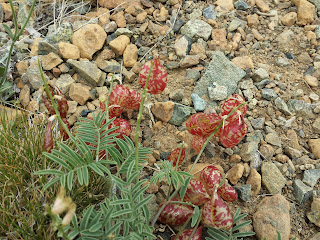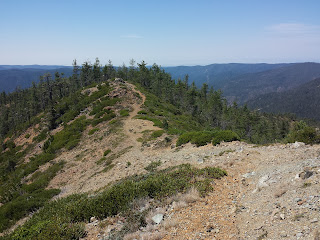I've got blisters. An inch-long blister on the right heel, and an inch high blister on my second toe. And a bit of heat exhaustion. S.D. is tired too, we just slept for a solid ten hours. I'm also a bit rattled after our first bear encounter. The good part, however is that, we're not too sore! Phase Two, the phase of our plan where we are getting in shape to go backpacking is a bit more difficult than expected. It's fun, and the scenery, bicycle riding, and hikes have been great but the bodies and minds are just taking a bit longer to get into the spirit of this phase.
 |
| Redwoods and the Smith River |
Our current base camp is Panther Creek campground. It's in the Smith River Recreation Area, in far Northern California, just a few miles north and east of the Jedidiah Smith Redwood Park. The weather for late June / early July has been unexpected hot; 90's in the daytime, 60's at night. But "it's a dry heat" the locals tell us, so it's not bad.
Walking through the redwoods two days ago, it really wasn't. They grow about 10 miles from the
coast so the temperature was about 15 degrees cooler. Additionally they provide shade. We hiked along the Mill Creek for 8 miles, marveling at one awesome tree after another. Following that I went for a swim in the Smith River and that's when I noticed the toe blister. It was huge! That night I drained and bandaged it. We figured the shoes had been the main source of the problem and planned to switch them out with my old North Face 940s for the following day's hike to... the Devil's Punchbowl.
 |
| "Gentle" Switchbacks up to the Punchbowl |
The Devil, or Satan, if you prefer, tends to be the namesake for nasty, inhospitable places. From the photo's we'd seen of the Punchbowl however, it looked like he'd finally gotten a good one. The Punchbowl is a glacial cirque lake high in the Siskiyou mountains. God's country. And we were really looking forward to the roughly 8-10 mile hike. With the 940s I wasn't worried about the blister, and we figured we were ready for a more difficult trail.
I say, 8-10 miles when describing the hike because while the trail is the same no matter where you read about it, the mileage does vary. As does the difficulty rating concerning the last mile of switchbacks that climb 1000 feet. Our original trail description noted then as 'gently switch backs which made the trail possible for the average hiker'. The one I read today called them "serious and demanding." We took a photo, you make the call.
Anyway we set off early in the morning. Temperatures in the valley were again forecasted in the 90's. Up in the higher elevations we'd figure they'd be a good 10-15 degrees cooler. The forest service road that took us to the trail head, certainly took us up in elevation also - along a 15 mile, single lane road where one shoulder was a cliff and the other a rock face. Half way up that, we scared a mother bear and her cub, who then ran up the road ahead of us.
Bear spray double-checked and loaded into S.D.'s pack, we set off on the trail at about 9:00am. At about 10:00 we stopped for a snack and had our first out-of-car bear experience. We heard a branch snap up the mountain and to the right. S.D. said it was a squirrel. Then another branch snap. Slightly closer. S.D. said it was a deer. I asked where? S.D. stood up and said, "it's a bear." Waved his arms and said "Go away bear." It turned out to be a sow and cub foraging. I informed the bears that 'we have bear spray'. And they did run away, sort of. They paralleled the trail about 300 yards away and then turned to go further up the mountain. S.D. asked if I really thought they understood "bear spray"? Hey, bears are smart.
After that little bit of fun we continued on, and soon up. The temperature was also going up. When we came out of the tree line, about 3/4 of a mile from the punchbowl it must have been 90 something degrees. Between the heat and the adrenaline from the bear encounter, I was beat. (or beat and bitchy if S.D. was telling the story). But we could see the outer rim of the punchbowl, across the dark, hot, exposed rock, from where I collapsed and slowly we made our way. First over a sweet little creek, then around the first pond, and then up the final climb to the punch bowl.
While I managed to take a photo, S.D. realized that I was not so much bitchie as dealing with heat
exhaustion. He soaked a rag in the water and used that to cool me off. Then I soaked some more in the lake and really began to appreciate the Devil's Punchbowl. Sure I was beat, and we still had a long way back to get to the car, but this place was amazing. Don't get me wrong all the exposed rock made it hotter than hell (reference intended) but it was beautiful. On the way back we talked with two backpackers who were planning to camp there. They'd heard it was even more amazing in a full moon. I can only imagine.
The hike back to the trail head was long and hot, and with me whacking bushes so the bears could hear us and S.D. getting tired, we were more than glad when we reached the van. It had been a hard hike, both physically and mentally. We'd had plenty of warning that there would be bears. Seeing them, and seeing how quietly they travel through the woods, it's just taking some getting used to. Hopefully the blisters will heal quickly, a lay day will help us recover from the heat, and I'll get used to the bears. Black bears, that is. Grizzlies, I'm still not sure of.











































